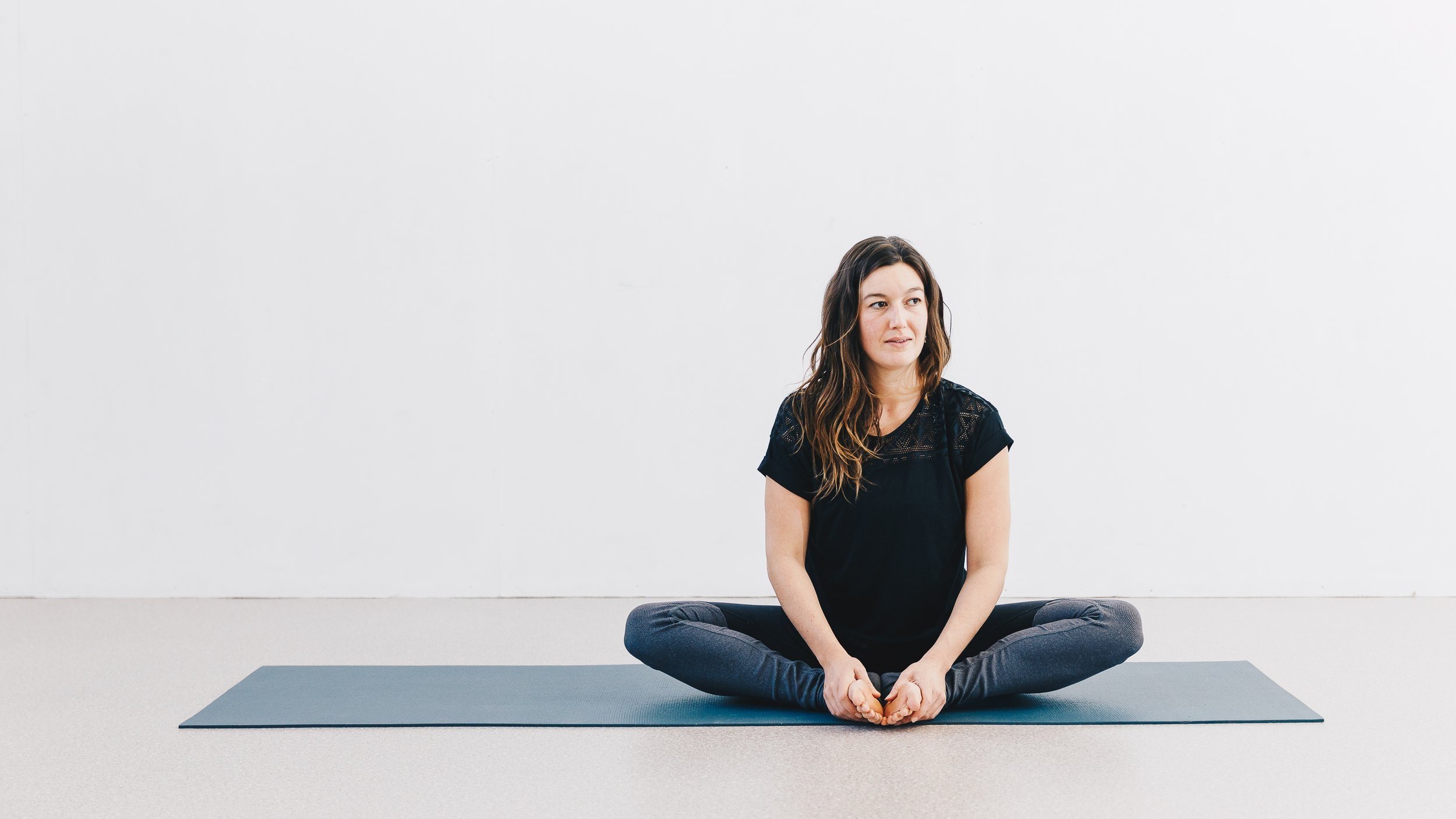THE EVOLUTION OF YIN
MOVEMENTS & MOMENTS
Deep Release for this
Season of Introspection
What is Yin? Growing up I would draw the yin/yang symbol for my art class assignments in primary school; the students and teachers were equally bemused. It seemed to be a ‘hippy’ symbol on the fringes. However for me it was entirely natural ~ growing up with a parent who actively practiced Taoism (pronounced Dow-ism) as multiple times a day they consulted the i-ching (an ancient book of Chinese divination interpreted in terms of the principles of yin and yang).
In simplistic terms Yang is the masculine active principle in nature of light, heat & dryness (think mid-summer heat). While Yin is the feminine passive principle in nature of darkness, cold, & wetness (a cold and rainy winter).
Yin practice analyses various yoga techniques from the perspective of yin and yang, with the most relevant aspect being the elasticity of the body’s tissues. Yang tissues are muscles: more fluid-filled, soft, and elastic and yin tissues are the fascia or connective tissue (including ligaments and tendons) while bones are drier, harder, and stiffer. Yin yoga, although relatively new to the Western world, takes inspiration from Chinese Taoist practices. In the 1970s, martial arts expert and Taoist yoga teacher Paulie Zink introduced the concept of Yin yoga to the United States. Later, Paul Grilley and Sarah Powers further developed and popularised this practice, emphasising the importance of long-held, passive postures that target the connective tissues of the body.
Yin involves variations of seated and supine poses typically held for 3 to 5 minutes, accessing deeper layers of fascia. Yin is designed to target connective tissue around the joints (namely the knees, pelvis, sacrum, and spine). It is a gentle and introspective practice, offering a sanctuary of stillness and tranquility amidst the chaos (although just because the body is in stillness does not mean the mind will be ~ Yin is a practice to constantly learn breath-work and meditation techniques).
The overarching premise of Yin is that the practice hydrates tissues through postures, breath and sequencing. Yin yoga primarily focuses on accessing the deep layers of fascia, ligaments, tendons, and joints. By surrendering to the pose and maintaining stillness, practitioners stimulate the flow of energy and enhance flexibility.
Deep Tissue Release: Yin yoga facilitates the release of tension and tightness in the body's deeper layers; improving flexibility, joint mobility, and posture.
Cultivating Mindfulness: The extended duration of poses encourages us to develop patience, mindfulness, and introspection.
Meridian Activation: Targeting the body's meridian system and stimulating energetic pathways harmonises vital functions & promotes overall well-being.
Stress Relief & Relaxation: Activating the parasympathetic nervous system we enter a state of deep relaxation, reducing stress, anxiety and overwhelm.
Improved Energy Flow: Working to remove energetic blockages, allowing the Qi (life force energy) to flow freely throughout the body; enhancing vitality.
During winter, a yin yoga practice can help us replenish our energy reserves and prepare for the coming seasons of growth and activity.
Meridians, also known as energy channels or pathways, are a fundamental concept in Traditional Chinese Medicine (TCM) and are an essential component of yin yoga. According to TCM, the meridians are invisible pathways through which Qi (life force energy) flows throughout the body, nourishing and supporting all functions. There are 12 primary meridians in the body, each associated with specific organs and interconnected with various physical, mental, and emotional aspects of our well-being.
In yin yoga, the understanding and activation of meridians are important for several reasons:
Energetic Balance: Yin aims to restore and balance the flow of Qi in the body. We target specific meridians through long-held poses, thus stimulating and nourishing the energy pathways, promoting overall balance and vitality.
Organ Health: Each meridian is associated with a specific organ and its related functions. By working with the meridians, yin helps to support the health and proper functioning of these organs.
Emotional & Mental Well-being: According to TCM, each meridian is linked to specific emotions and mental states. By activating the meridians through yin we may release energetic blockages. This can help alleviate stress, anxiety, and stored emotions, allowing for a greater sense of calm and/or clarity.
Targeted Healing: Yin sequences focus on specific meridians. By understanding the meridian system and its associated qualities, practitioners can create targeted practices to support and promote healing in specific areas of the body.
Holistic Approach: Yin yoga's integration of meridians aligns with the holistic philosophy of traditional Chinese medicine, which views the body, mind, and spirit as interconnected. By working with the meridians, yin integrates all aspect of wellbeing.
By activating and balancing the meridians in yin yoga practice, practitioners can tap into the subtle energy of the body and promote healing, restoration, and overall vitality. The combination of long-held poses, mindfulness, and focus on meridians makes yin yoga a unique and powerful practice that goes beyond physical flexibility, extending into the realm of energetic and holistic well-being.
Some of the meridians that are prevalent in winter yin yoga practices include:
Kidney Meridian: associated with the element of water and is particularly relevant during the winter season. Governing the health of the kidneys and bladder, influencing bone strength, reproductive health, and vital essence.
Urinary Bladder Meridian: running along the entire back of the body; this plays a crucial role in releasing excess heat and tension. It helps to calm the mind and promote relaxation.
Spleen Meridian: connected to the earth element, spleen meridian is responsible for transforming food into energy. Aiding digestion it supports the immune system, and fosters a sense of stability and being grounded.
Winter is a time of introspection, reflection, and restoration. The yin energy of the season aligns beautifully with the principles of Yin yoga. During winter, a yin yoga practice can help us replenish our energy reserves and prepare for the coming seasons of growth and activity.
Winter Yin Yoga Postures for Rest:
Supported Child's Pose (Balasana): a gentle forward-fold stretches the hips, thighs, and lower back. It activates the Kidney meridian, which helps restore vitality and supports the body's energy reserves.
Reclining Butterfly Pose (Supta Baddha Konasana): to open the hips, releasing tension and promoting relaxation. It stimulates the Kidney and Spleen meridians, creating a sense of stability and nourishment.
Dragon Pose (Yin Variation): deep hip-opener stretches in the hip flexors. Activating the Urinary Bladder meridian, which helps release tension in the back-line and opens emotional balance and resilience.
Supported Fish Pose (Matsyasana): a gentle heart-opener that stretches the chest, shoulders, and throat, promoting a sense of surrender and receptivity. It stimulates the Kidney meridian, enhancing vitality and emotional balance.
Yin yoga provides an opportunity to embrace the restorative power of the season to nurture our mind, body, and spirit. By integrating gentle and nourishing postures that target specific meridians, we can tap into the healing energy of winter and experience deep relaxation, improved energy flow, and overall well-being.
We have two wonderful short Yin sequences online we would love to gift to you, check out the link below for ‘Yin for Backline’ & ‘Yin for Upper Body & Spine’; now complimentary on our Virtual Studio platform.

